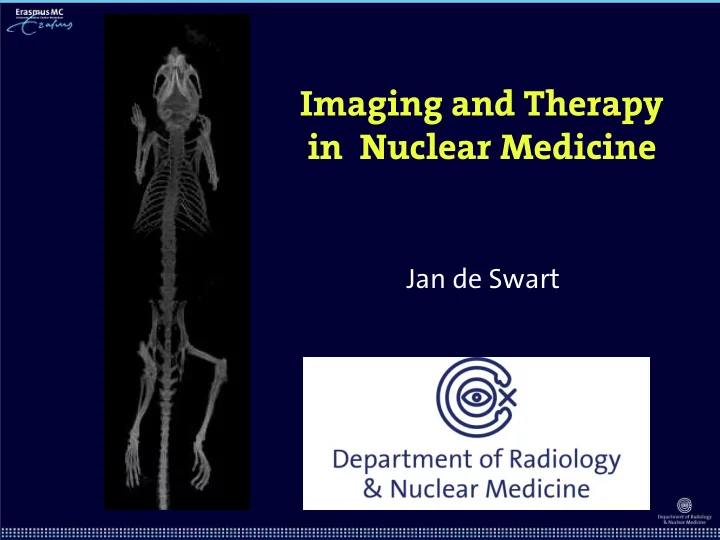

Imaging and Therapy in Nuclear Medicine Jan de Swart
PET and SPECT • Ultra high sensitivity (pM-nM), quantitative • Tracer quantities (no pharmacological effect) • Function over time: • imaging of receptor expression, apoptosis and angiogenesis, enzymatic activity, substrate metabolism, drug pharmacokinetics, DNA synthesis and (reporter) gene expression • Early imaging, whole body and 3-D, non- invasive
Photo Multiplier Tube
Human versus mouse Mouse, approx.. 10 cm. (without tail) and 10 gram Much better resolution needed! Human, approx.. 175 cm. and 65 kg
SPECT imaging Object Object 1:1 projection magnifying projection NaI(Tl) NaI(Tl) PMT PMT Intrinsic resolution Intrinsic resolution Conventional SPECT: Pinhole SPECT: • Parallel-hole collimator, large FOV • Magnification, but small FOV • Spatial resolution: ~1cm • Spatial resolution: ~1mm
Pinhole design
Pinhole collimator
Improved resolution with parallel-hole SPECT with pinhole SPECT Resolution: 6 mm Resolution: < 1 mm Sensitivity: 100 cps/MBq Sensitivity: 600 cps/MBq
SPECT systems
MILabs VECTor 5 SPECT/PET/CT/OI
Optical Imaging
Optical Imaging
Detection range of imaging modalities Anatomy Physiology Metabolism Molecular X-Ray/CT US MRI PET/SPECT Nuclear Optical Weissleder, Radiology 1999; 212: 609 – 614 Combination!
PET/CT
SPECT/MRI SPECT: 99m Tc-DMSA MRI: T2 weighted
PET Detection
PET System 18 FDG Siemens Inveon
Advantages of PET and SPECT Contribution of micro-SPECT and -PET to science: – Partly replacement of sectioning, counting and autoradiography – Reduction of number of animals required – Dynamic and longitudinal imaging in intact animals – Contribution to understanding of gene functions – Acceleration of pharmaceutical development – Breakthroughs in areas like cardiology, neurosciences and oncology
PET versus SPECT PET and SPECT both uses many radiolabelled compounds as molecular probes. Advantages of PET: • higher sensitivity • use of physiol. tracers • better quantification • less noise Advantages of SPECT tracers: • have longer half-lives • are cheaper • more widely available • multiple labelling studies • higher resolution • Dual isotope studies
Performing animal imaging • Equipped with heated rat- and mouse beds • Connection for isoflurane anesthesia Heating Isoflurane NanoSPECT/CT system
18 F-FDG Glucose analog, hydroxyl group (-OH) is replaced by Fluor-18 ( 18 F) • Oncology • Cardiology • Neurology • Inflammation
Influence of animal handling IV iso IV awake IP iso IV awake 60min IV no fasting FDG Fasted Yes Yes Yes No No Preheating 30° Yes Yes Yes No Yes Injection IV (iso) IV (awake) IP (iso) IV (awake) IV (iso) Method Cannula Needle Needle peritoneal Needle Cannula tail vein tail vein tail vein tail vein 60’ Awake after injection No No No No 90’ 90’ 90’ 30’ 90’ Scantime MIP (@ 180°) White-Black: 0-15% max Bq/ml ∑ 90” scans shown
Organ function 125 I 99m Tc-MDP
Radionuclide – chelator – peptide O N D-Phe - Cys - Tyr HOOC C H D-Trp S N N S Lys N N Thr(ol)- - Cys -Thr HOOC COOH Octreotide 111 In 68 Ga 177 Lu
Peptide receptor imaging Peptide receptors over-expression on tumours 1. Intraveneus injection of SST receptor radiolabeled peptide 2. Receptor binding 3. Internalization 4. Visualization Tumor cell radiolabelled peptide analog
PRRT PRS Peptide Receptor Scintigraphy Peptide Receptor Radionuclide Therapy 111 In, 99m Tc ,… 90 Y, 177 Lu ,… low energy 225 Ac… transfer high energy high tissue transfer penetration low tissue range penetration range
[ 177 Lu-DOTA]octreotate in small animals 278 MBq 50 MBq [ 177 Lu-DOTA]octreotate [ 111 In]Octreoscan 5 days after therapy 4h after injection (injection radiopeptide) 28 days after therapy
Recommend
More recommend